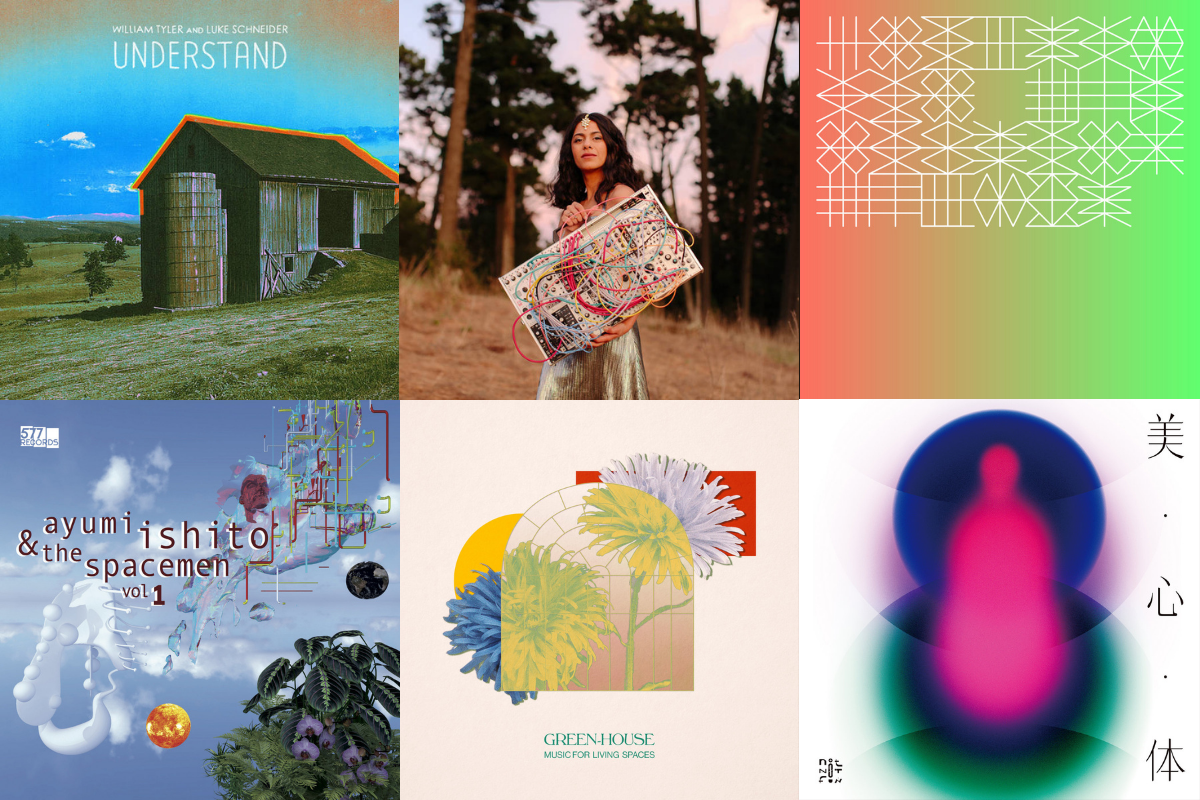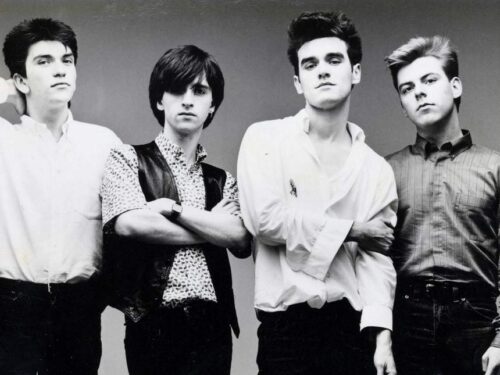We’re in a golden age of ambient music. “Furniture music” has quietly, almost imperceptibly moved toward the mainstream. Musak lives on in its original form but has also mutated, morphed, and branched out — in massively popular, algorithm-gaming streaming playlists; wellness apps; and compilations designed for zoning out in very specific everyday situations. Rarely do we abide a silent moment. A tidal wave of musicians working today have tapped this vein and turned this spike in demand — this modern predilection for lulling, atmospheric beats, tones, and textures — into art. Through abstraction, suggestion, and evocation, ambient music conveys paradoxes. Binaries coexist: stillness and exploration, absent-mindedness and deep focus, calm and restlessness, peace and turmoil, harmony and discordance, specificity and inscrutability, self-reflection and universality. The pandemic has intensified the craving for innovative ambient music, accelerating its upward trajectory. As a result, ambient has branched out and infiltrated different genres and become more adventurous and expansive. Music that eases and/or mirrors an addled mind is needed now more than ever as we claw at the walls in isolation or reel from the aftereffects. Ambient is counter-programming in a heady time. Listed here are some brilliant ambient releases from 2021, a sampling of what the genre sounds like at its peak.
Arushi Jain, Under the Lilac Sky

Ambient music in the Asian subcontinent traces back hundreds of years. Indian classical music is built on extended drones and improvisation. Its building blocks consist of hundreds of ragas; given a discrete scale, a few simple notes — a select pentatonic or heptatonic scale — the potential for spontaneity is infinite. On the cover of Under the Lilac Sky, Arushi Jain’s debut under her own name, the composer/producer/synthesist wears her instrument, with its beautiful bramble of colorful patches, like a garment. It’s a fitting image for this record that combines modern and ancient, personal and cultural. Drawing on Hindustani classical, Jain composed these songs using the ragas des, khamaj, kafi, and durga. These scales are all associated with evening hours, from sunset through midnight, and are meant to evoke a calm, meditative, and melancholic aura. Her modular compositions bring to mind raga disciples Terry Riley and late-period Alice Coltrane, as well as the vibrant buchla work of “Diva of the Diode” Suzanne Ciani (with whom Jain has shared a stage). For contemporary peers, think Mary Lattimore and Juliana Barwick, with Jain’s ethereal voice woven into the mix as she sings aalaaps, sargam, and dadra.
Jain’s choice to shed her OSE alias here and record under her own name enhances the personal bent of the album, a reclamation of her upbringing in New Delhi (she urges listeners to donate to organizations such as the Hemkunt Foundation, Oxygen for India, and the TWEET Foundation) and her journey to Brooklyn, by way of California, where she studied engineering at Stanford. Her work here is an earthier, more subdued, and more accomplished version of what she tinkered with on With & Without. Largely composed for a sunset performance at the opulent Alsisar Mahal palace for the Magnetic Fields Festival in Rajasthan, Under the Lilac Sky’s twilit setting is a nod to ritual, examining how environmental stimuli shapes your perspective and your emotions and perception, sometimes unconsciously, even imperceptibly. There’s rich symbolism in setting an album at sundown, as darkness creeps over the horizon and deepens and obscures. At times, it feels like this is the permanent state of the world, and it’s easy to focus on the blackness, to let the unease consume you. On drifting modular excursions — like the warm glow of opener “Richer Than Blood,” the majestic “Look How Far We’ve Come,” and the softly rumbling “My People Have Deep Roots” — Jain chooses instead to marvel at the beautiful hues. The transcendent title track closes the album by stitching together Jain’s panoramic stylistic vision — playful, profound, eye-opening, and brilliant. Under the Lilac Sky gifts you with the perfect context and frame of mind to attune yourself to its wavelength, letting you tap into a cultural context that might otherwise feel impenetrable.
William Tyler & Luke Schneider, Understand

Midway through Ted Chiang’s speculative sci-fi novella Understand, the protagonist, who has been given an experimental drug to heal brain damage, marvels at his newly acquired superintelligence: “The quotidian patterns of society are revealed without my making effort,” he says. “I acquire years of education each week, assembling ever larger patterns. I view the tapestry of human knowledge from a broader perspective than anyone ever has before,” he says. Obviously, the rest of the plot is not so rosy, but this moment of epiphany feels consequential when thinking about William Tyler and Luke Schneider’s Understand, which was inspired by Chiang’s story. Understand is a pure transmission from the depths of the pandemic, when many of us are internalizing case counts, death tolls, the bleeding-edge of vaccine research, and the hazards of everyday environments. Think of this as its own form of hyperawareness and heightened perception, seeking out the patterns to find a way clear. Understand, a collaborative EP project between prodigious fingerpicking expert Tyler (alum of Lambchop, Silver Jews) and pedal steel ace Schneider (session and live-band specialist for Margo Price, Caitlin Rose, and Orville Peck), was recorded in Nashville in a single day while the two established partners found themselves together, shut in and locked down.
Two virtuoso axemen in lockdown sounds like the recipe for sprightly, crescendoing one-upmanship. But this is a searching, tender record that seamlessly melds the two artists’ styles. Tyler’s signature indie Americana, last heard on his sensitive score for Kelly Reichardt’s First Cow, has become increasingly billowing, atmospheric, and sculpted over the years. And Schneider’s liquid new age drone work reached a thrilling high-water mark on his last effort, Altar of Harmony. On Understanding, the two players dissolve their sympatico sensibilities to create what they like to call “cosmic pastoral.” Tyler handles electric and acoustic guitar, synthesizer, and bass guitar while Schneider holds down pedal steel guitar (a 1967 Emmons Push/Pull, no less) and banjo to create a country-folk/kosmische cocktail with swirling feedback and forlorn licks. The four tracks all stand on their own, each with a distinct flavor and the balance of elements carefully modulated and held together with a halo of sonic effects. There’s anxiety at the edges, the two partners searching for meaning while in imposed isolation. But it’s also an affecting expression of friendship and musical camaraderie, of circumstance and dialogue, of two artists with distinct voices finding common ground and new sonic territory while the world grinds to a halt.
UNKNOWN ME, BISHINTAI

Jim O’Rourke is an underground zelig in self-imposed exile, if you count living and working in Japan exile. He has turned out an incredible amount of Serge synthesizer ambient music over the last decade, often under his diaristic Steamroom cul-de-sac. It makes perfect sense that he shows up on BISHINTAI, the latest from mysterious Tokyo outfit UNKNOWN ME. What’s billed as their “inaugural LP” is really their fourth, coming on the heels of their other Not Not Fun releases Astronauts and subtropics. BISHINTAI is imbued with the spirit of O’Rourke’s Steamroom as well as his sly and joyous solo outings. His contribution on “Have a Noble Meal” gives the album a tone and a center of gravity. But there’s much more to behold. “Bishintai” is a kanji compound meaning “beauty, mind, body,” and this is an album with a wily sense of humor about the palliative benefits of ambient. There’s a shapeshifting narrator — counterintuitive for wallpaper music — on three tracks that demarcate the beginning, middle, and end. It talks to you, checks in on you, asks about your comfort level. But it’s slightly unnerving, this new age-“Fitter Happier” robot voice affecting a soothing coo that gets progressively more inhuman. It’s both tongue-in-cheek and philosophical, like The Books’ “Group Autogenics.”
But these elements are counterbalanced by the lush, ranging music. O’Rourke is not the only ringer; the album also includes contributions from foodman (bringing a touch of footwork energy to “Breathing Wave”), MC.Sirafu (on the tropical sojourn “Moisture of View”), and Lisa Nakagawa (on the pop-leaning “Treadmill”). The main crew, the quartet of Yakenohara, P-RUFF, H. Takahashi, and Osawa Yudai, built the album from software, synthesizers, steel drums, and “rhythm boxes,” creating a sort of loungey, space-age kitsch that’s drawn comparisons to the likes of The Gentle People. But this sensibility is elevated with a clear affinity for classic kankyō ongaku, from the likes of Hiroshi Yoshimura, Yoshiaki Ochi, and Yoshio Ojima. In a year where we necessarily found comfort in the inanimate objects and nascent-AI around us, UNKNOWN ME’s bizarre and slightly disconcerting fever dream is heady and timely. There’s a tension at the heart of the record: can we meditate using machines? UNKNOWN ME takes pleasure in casting and breaking their own spells to test their new age music’s fourth wall. Welcome to the art-damaged world of UNKNOWN ME.
Green-House, Music for Living Spaces

If a plant is hit with sustained strong winds, it will alter its shape to improve its wind resistance. When corn or lima beans are attacked by caterpillars, the plants emit a scent that attracts parasitic wasps. When sagebrush is clipped, it releases a chemical warning to plants in the area, triggering a chain reaction. All this to say that the world of vegetation around us is mystifying and complex. These mutations scan as reactive, communicative, even sentient. It’s within this frame that Green-House’s verdant and compassionate music lives. Music for Living Spaces is an outgrowth of Six Songs for Invisible Gardens, the debut EP by Los Angeles-based artist Olive Ardizoni. Their debut full-length features more melodic definition and a wider range of sounds and influences, tapping into a fertile lineage of ambient or ambient-adjacent albums in communion with the humble plant life we arrange and care for, like Mort Garson’s cult relic Mother Earth Plantasia, Stevie Wonder’s reappraised Journey Through the Secret Life of Plants, Virginia Astley’s gentle, pastoral classic In the Gardens Where We Feel Secure, many such works of Takashi Kokubo, and Emily A. Sprague’s astonishing hill, flower, fog. Like those albums, Music for Living Spaces teems; a winsome mood abounds and the tones are light and abuzz, with a quality not far removed from a lullaby. It’s remarkable how an album like this terraforms artificial, synthesized sounds — programmed keys, xylophone, horns, and woodwinds — to make them feel organic.
On Six Songs, Ardizoni made a point to credit “house sounds” as one of the composed sonic elements in the liner notes, and Living Spaces continues this focus, with musique concrète enhancing the atmosphere and evoking a vivid setting. Amid the bed of rounded tones, the lush warbling melody, and the flutter of flute on opener “Top Soil,” there’s a light trickle of water in the mix, like a garden hose left running on a stone walk. And birdsong appears on, fittingly, “Bird of Paradise.” Eventually, Ardizoni’s voice enters on the penultimate track, “Find Home,” a melancholy ode to the comfort of domesticity; her voice has a soft-focus, disaffected tone to it, something like Julee Cruise, and the album briefly skirts dream pop. For a record that feels precious and familiar, there are surprising layers. For one, it’s explicitly a pandemic record, so it speaks to a time when many of us are confined and need to create a whole habitable world within a limited space. In this context, the humble pleasures of a garden, the routine of tending it, the significance of the lifecycles and yield, are magnified. And as a non-binary artist, Ardizoni’s focus on comfort and safety and compassion carries an added weight, a “gateway to empathy.” On Living Spaces’ sun-dappled, dewy biome, contentment and willful naiveté are acts of empowerment.
Lori Scacco, The Order of Things

The liner notes for Lori Scacco’s The Order of Things quotes a poem from the late Etel Adnan. In part: “Music is the vibration of time itself in an uninterrupted surge, the modulation of thinking, the moon’s hidden side, making time inevitable.” This turn of phrase is complemented, perhaps subtly contradicted, by Scacco’s own contention that the 33-minute piece is about “tracing a suspended reality in which the chronology of routine was [her] pendulum.” However you read it, The Order of Things is a work divided against itself, caught between self-actualization and indecision. Deploying her signature mix of micro-sound, melody, resonance, and analog and digital processing, she creates music that explores liminal spaces. The Order of Things is a single track but it covers an astonishing range of tones and styles. Scacco’s reference to Adnan is also apt because the piece is reminiscent of the colorful, smooth daubs of the artist’s early paintings — impressionistic and abstract — with clean lines and distinct pieces, and clear sections of vibrancy and darkness. Released on Longform Editions, the Sydney, Australia, label known for curating absorptive listening one-offs from adventurous artists, Scacco’s entry had a long path from beginning to end. She started work on it well before her hometown New York City went into lockdown, then put the composition down “through a long period of collective trauma and reckoning,” before finally finishing the piece last summer.
The record follows a similar path to Laurie Spiegel’s interstellar disc The Expanding Universe, with a relatively boisterous beginning that dilates. Only Scacco explores an interior universe, tumbling deeper into her mind and emotions, expertly expanding and contracting and bringing the listener along through each mood swing. Even the sections have shifting timbres and stylistic variety, such as the first phase, which moves from something like an ersatz steel-drum Tropicália to a motorik Reichian minimalism. By the midpoint, we’ve traveled through luminous rounded tones and devotional organ to arrive at a lightly throbbing celestial drone. In the final stretch, the glistening drone that ties the piece together drops a register and Scacco settles into an introspective dark ambient mode. The Order of Things feels like Scacco’s voice coalescing, bringing all her experience, collaborations, contributions — as a member of the electro-pop duo Storms; playing in the live bands for Savath y Savalas and Helado Negro; and composing scores and sound design for films, video games, dance performances, and art installations — to bear in a remarkable, intoxicating piece that journeys from animated to apprehensive and back again.
Florian T M Zeisig, Music for Parents

Florian T M Zeisig ended 2020 with You Look So Serious, another in a line of process-driven releases with a killer hook. He painstakingly chopped up a cassette of Enya’s Watermark into 426 four-second loops then reassembled the album into a brooding, Basinski-esque reclamation. But he began the following year in a much different mode. With Music for Parents, Zeisig delivered his coziest, most contented set. Amid a solo catalog of fraught experiments, Music for Parents is a patient, calming outlier, more an extension of his work in the duo OCA, particularly the album Aging. Music for Parents has its own high concept: On a trip to visit his parents in Bavaria, Zeisig found that they had a new vibroacoustic mattress, to aid with sleep issues, and he became fascinated by it as both a concept and as a sound source. Apparently, this type of thing, developed in Norway by Olav Skille in the ’80s, is popular in Scandinavian countries, in keeping with their emphasis on hygge living. Zeisig spent the next two years researching vibroacoustic sound therapy, resulting in his third full-length.
The album is meant to function as a vibroacoustic experience, with a low end pitched between 30-120Hz. It’s not meant to express anxiety, restlessness, or chronic pain; it mimics a purported cure, especially when paired with a vibroacoustic mattress or wearable bass device. But the record’s success as sound therapy is beside the point because the music itself is so accomplished and enveloping. What’s more, the vibroacoustic angle is only part of the concept. The cover of the album was drawn by Zeisig’s father, a view from his perspective, through his square glasses frames, reclining in a pool. And the liner notes close by wishing his mother a happy 60th birthday. Unsurprisingly, unlike his other works, which were more documents of a tumultuous present tense, such as Coatcheck, a deep house/dub album with material sourced from his time punching the clock at various Berlin clubs, Music for Parents is a more nostalgic piece, imbued with memories of his childhood and his family history. The album begins, on “Dad Is Painting Again,” with uncanny, compressed field recordings — chirping insects, babbling water, birdsong — before finding the gentle roll of his synth sine waves, which he holds for the duration of the extended piece, letting a five-note or seven-note synth pad figure bubble to the surface every so often. It’s the main mode of the album: a bed of luminous tones that gently rise and fall, not quite settling into a predictable rhythmic pattern, but still reassuring. Occasionally, a new sound will gently skim across the top, like the minimal piano on the closing track, “Smoking by the Pond.” His soothing soundscapes are centered and loving, basking in the uncool of finding a sanctuary outside the city and slipping into a slower pace of life.
Ayumi Ishito, Ayumi Ishito & The Spacemen Vol. 1

Last year featured not one but two high-profile ambient-jazz albums: Nala Sinephro’s Space 1.8 and Floating Points, Pharoah Sanders, and the London Symphony Orchestra’s Promises. Both are incredible. But I got more lost in the playful, improv-heavy album from Ayumi Ishito, with her new outfit The Spacemen. Ayumi Ishito & The Spacemen Vol. 1 is a free-form collage of jazz styles and grooves that is always shifting in and out of focus. Ishito and crew are after an exploratory, Sun Ra-inspired galactic mission — “a valiant attempt at capturing the interstellar experience,” says the artist statement — but the album is not trying to depict the vastness of the eerie infinite, and the album is not beholden to the predictable laws of physics that dictate the movement of celestial bodies. It’s more chaotic — just chaotic enough to still qualify as ambient — like a collection of objects let loose in a zero-G capsule, bouncing off each other in random patterns. Ayumi Ishito leads the band on saxophone, and The Spacemen consist of Theo Woodward (synthesizer, vocals), Nebula and the Velvet Queen (theremin), Jake Strauss (guitar, bass), and Steven Bartishev (drums). Ayumi Ishito, a Berklee graduate, was born and raised in Ishikawa, Japan, and she is a regular member of an ever-widening array of New York-based ensembles and projects, including The Jazz Thieves, GADADU, The Eighty-pound Pug, Platypus Revenge, Big Squid, and Marc Edwards & Slipstream Time Travel. Ayumi has been leading her own group for over a decade now.
On Vol. 1, theremin, synths, and a bounty of electronic effects orbit the center of gravity from the analog instruments. The lengthy first track, “Looking Through Ice,” sets the tone using Forbidden Planet-esque whirs and pulses, submerged chants with a Middle Eastern flair, clean guitar plucking interspersed with wah-wahs, and asymmetrical, skittering drums that sometimes slip in the pocket. This configuration recurs throughout the album with new dimensions and effects added: walking bass and electronic tape warbles on “Hum Infinite,” uncredited trumpet on “Misspoke” that gets increasingly uncanny, and funk rhythms on closer “Constellation Ceiling.” As bandleader, Ayumi Ishito offers up a stunning vision for the potential of cosmic jazz today, an unhurried, untethered, genre-bending brew of ambient, electronica, new age, and loose improvisation with plenty of open space. It’s not hung up on the fat notes and depth of field of cosmic jazz outings that came before it; instead, the record finds a sonic middle register and dots the field with bursts and streaks of color. Vol 1. shoots for the stars, taking a fantastical journey through the cosmos, but really it expresses the joy of talented musicians with chemistry and a shared psychedelic vision bouncing off each other in a room.




